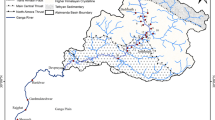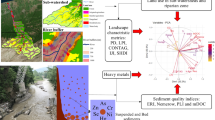Abstract
The objective of this study was to evaluate the relative effects of watershed land-use on streambed substrate composition in eight low-order tropical streams. Data were collected at 24 sampling sites for eight wadeable streams in the Pirapó River Basin, southern Brazil. According to the percentage of impervious surfaces in the watershed, we defined the streams as either urban or rural. We estimate the percentages of the different streambed substrates, hydrological variables, and the rainfall intensity. The results showed that silt, sand and coarse particulate organic matter (CPOM) contributed to significant differences in streambed substrate composition between urban and rural streams. Silt, sand and CPOM were found in a higher mean proportion in the rural streams. Probably the urban streams have a greater bed load, promoted by precipitation and discharge, than rural streams, especially fine sediment. Rural streams have soft hydrographs, with stream flow slowly increasing during a rainstorm and subsequently decreasing over a long period after the rain event is over. These characteristics can provide the lixiviation of fine sediments into the stream channels due to land-surface clearance for agricultural activities and their accumulation in the streambed due to the moderate discharge regime.





Similar content being viewed by others
References
Alberti M (2009) Advances in urban ecology: integrating humans and ecological processes in urban ecosystems. Springer, New York
Alberti M, Booth D, Hill K, Coburn B, Avolio C, Coe S, Spirandelli D (2007) The impact of urban patterns on aquatic ecosystems: an empirical analysis in Puget lowland sub-basins. Landsc Urban Plan 80:345–361
Anderson MJ (2001) A new method for non-parametric multivariate analysis of variance. Austral Ecol 26:32–46
Annable WK, Watson CC, Thompson PJ (2012) Quasi-equilibrium conditions of urban gravel-bed stream channels in southern Ontario, Canada. River Res Appl 28:302–325
Booth DB (1990) Stream channel incision following drainage basin urbanization. Water Resour Bull 26:407–417
Booth DB (1991) Urbanization and the natural drainage system: impacts, solutions, and prognoses. Northwest Environ J 7:93–118
Booth DB, Jackson CR (1997) Urbanization of aquatic systems: degradation thresholds, stormwater detection, and the limits of mitigation. J Am Water Resour Assoc 33:1077–1090
Booth DB, Karr JR, Schauman S, Konrad CP, Morley SA, Larson MG, Burges SJ (2004) Reviving urban streams: land use, hydrology, biology, and human behavior. J Am Water Resour Assoc 40:1351–1364
Borcard D, Gillet F, Legendre P (2011) Numerical Ecology with R. Springer, New York
Camara G, Souza RCM, Freitasum GJ (1996) Spring: integrating remote sensing and GIS by object-oriented data modelling. Comput Graph 20:395–403
Campana NA, Tucci CEM (2001) Predicting floods from urban development scenarios: case study of the Diluvio basin. Urban Water 3:113–124
Chin A (2006) Urban transformation of river landscapes in a global context. Geomorphology 79:460–487
Di Giulio M, Holderegger R, Tobias S (2009) Effects of habitat and landscape fragmentation on humans and biodiversity in densely populated landscapes. J Environ Manag 90:2959–2968
Dufrêne M, Legendre P (1997) Species assemblages and indicator species: the need for a flexible asymmetrical approach. Ecol Monogr 67:345–366
Finkenbine JK, Atwater JW, Mavinic DS (2000) Stream health after urbanization. J Am Water Resour Assoc 35:1149–1160
Fitzpatrick FA, Waite IR, D’Arconte PJ, Meador MR, Maupin MA, Gurtz ME (1998) Revised Methods for Characterizing Stream Habitat in the National Water-Quality Assessment Program (Water-Resources Investigations Report 98–4052). Raleigh, U.S. Geological Survey. http://pubs.usgs.gov/wri/wri984052/pdf/wri98-4052.pdf. Accessed 4 Aug 2015
Gordon ND, McMahon TA, Finlayson BL, Gippel CJ, Nathan RJ (2004) Stream hydrology: an introduction for ecologists. Wiley, West Sussex
Hancock PJ (2002) Human impacts on the stream-groundwater exchange zone. Environ Manag 29:763–81
Hauer FR, Lamberti GA (2007) Methods in stream ecology, 2nd edn. Elsevier, Oxford
Instituto Brasileiro de Geografia e Estatística – IBGE (2015) Estimativas populacionais para os municípios e para as Unidades da Federação brasileiros 2015. http://www.ibge.gov.br/home/estatistica/populacao/estimativa2015/estimativa_dou.shtm. Accessed 18 Aug 2015
Jackson DA (1995) Protest: a procrustean randomization test of community environment concordance. Ecoscience 2:297–303
Johnson MP (2001) Environmental impacts of urban sprawl: a survey of the literature and proposed research agenda. Environ Plann 33:717–735
Jordan BA, Annable WK, Watson CC, Sen D (2010) Contrasting stream stability characteristics in adjacent urban watersheds: Santa Clara Valley, California. River Res Appl 26:1281–1297
Kang RS, Marston RA (2006) Geomorphic effects of rural-to-urban land use conversion on three streams in the Central Redbed Plains of Oklahoma. Geomorphology 79:488–506
Kondolf GM, Lisle TE, Wolman GM (2003) Bed sediment measurements. In: Kondolf GM, Piégay H (eds) Tools in fluvial geomorphology. Wiley, Chichester, pp 347–395
Köppen W (1948) Climatologia. Com um estudio de los climas de la tierra. In: Iapar, Cartas Climáticas Básicas do Estado do Paraná, Londrina, Brazil
Legendre P, Legendre L (2012) Numerical Ecology, 3rd edn. Elsevier, Amsterdam
Maack R (2012) Geografia Física do Estado do Paraná, 4ath edn. Editora da UEPG, Ponta Grossa
Malmqvist B, Rundle S (2002) Threats to the running water ecosystems of the world. Environ Conserv 29:134–135
McCune B, Grace JB (2002) Analysis of ecological communities. Gleneden Beach, Oregon
McCune B, Mefford MJ (2006) PC-ORD: multivariate analysis of ecological data. Version 5.0. MJM Software, Oregon
McMahon G, Cuffney TF (2000) Quantifying urban intensity in drainage basins for assessing stream ecological conditions. J Am Water Resour Assoc 36(6):1247–1261
Meyer JL, Paul MJ, Taulbee WK (2005) Stream ecosystem function in urbanizing landscapes. J North Am Benthological Soc 24:602–612
Nakamura F, Yamada H (2005) Effects of pasture development on the ecological functions of riparian forests in Hokkaido in northern Japan. Ecol Eng 24:539–550
Nanson GC (1981) Downstream reduction of rural channel size with contrasting urban effects in small coastal streams southeastern Australia. J Hydrol 52:230–255
Niezgoda SL, Johnson PA (2005) Improving the urban stream restoration effort: identifying critical form and processes relationships. Environ Manag 35:579–592
Oksanen J, Blanchet FG, Kindt R, Legendre P, Minchin PR, O’hara RB, Simpson GL, Solymos P, Henry M, Stevens H, Wagner H (2015) Vegan: community ecology package. R Package Version 2:2–1
Paul MJ, Meyer JL (2001) Streams in the urban landscape. Annu Rev Ecol Evol Syst 32:333–365
Peres-Neto PR, Jackson DA (2001) How well do multivariate data sets match? The advantages of a Procrustean superimposition approach over the Mantel test. Oecologia 129:169–178
Phillips CB, Scatena FN (2013) Reduced channel morphological response to urbanization in a flood-dominated humid tropical environment. Earth Surf Process Landf 38:970–982
Pizzuto JE, Hession WC, McBride M (2000) Comparing gravelbed rivers in paired urban and rural catchments of southeastern Pennsylvania. Geology 28:79–82
R development core team (2012) R: a language and environment for statistical computing. Vienna, Austria: R Foundation for Statistical Computing. http://www.R-project.org. Accessed 26 Oct 2012
Sala MG, Gasparetto NVL (2010) Enviromental fragility of soils in hydrographic basin of small orders: the case of basin of Ribeirão Maringá – PR. Bol Geogr 28:113–126
Shields FD, Copeland RR, Klingeman PC, Doyle MW, Simon A (2003) Design for stream restoration. J Hydraul Eng 129:575–584
Strahler AN (1957) Quantitative analysis of watershed geomorphology. Trans Am Geophys Union 38:913–920
Sudduth EB, Meyer JL (2006) Effects of bioengineered streambank stabilization on bank habitat and macroinvertebrates in urban streams. Environ Manag 38:218–226
ter Braak CJF (1986) Canonical correspondence analysis: a new eigenvector technique for multivariate direct gradient analysis. Ecology 67:1167–1179
ter Braak CJF (1994) Canonical community ordination. Part I: basic theory and linear methods. Ecoscience 1:127–140
Walsh CJ, Roy AH, Feminella JW, Cottingham PD, Groffman PM, Morgan RP (2005) The urban stream syndrome: current knowledge and the search for a cure. J North Am Benthological Soc 24:706–723
Wohl E, Jaeger KL (2009) Geomorphic implications of hydroclimatic differences among step-pool channels. J Hydrol 374:148–161
Wood PJ, Armitage PD (1997) Biological effects of fine sediment in the lotic environment. Environ Manag 21:203–217
Zaimes GN, Schultz RC (2011) Stream bed substrate composition adjacent to different riparian land-uses in Iowa, USA. Ecol Eng 37:1692–1699
Zar JH (1999) Biostatistical analysis. Prentice Hall, New Jersey
Zhou Y, Wang YQ (2007) An assessment of impervious surface areas in Rhode Island. Northeast Nat 14(4):643–650
Author information
Authors and Affiliations
Corresponding author
Rights and permissions
About this article
Cite this article
Cunico, A.M., Gubiani, É.A. Effects of land use on sediment composition in low-order tropical streams. Urban Ecosyst 20, 415–423 (2017). https://doi.org/10.1007/s11252-016-0603-8
Published:
Issue Date:
DOI: https://doi.org/10.1007/s11252-016-0603-8




